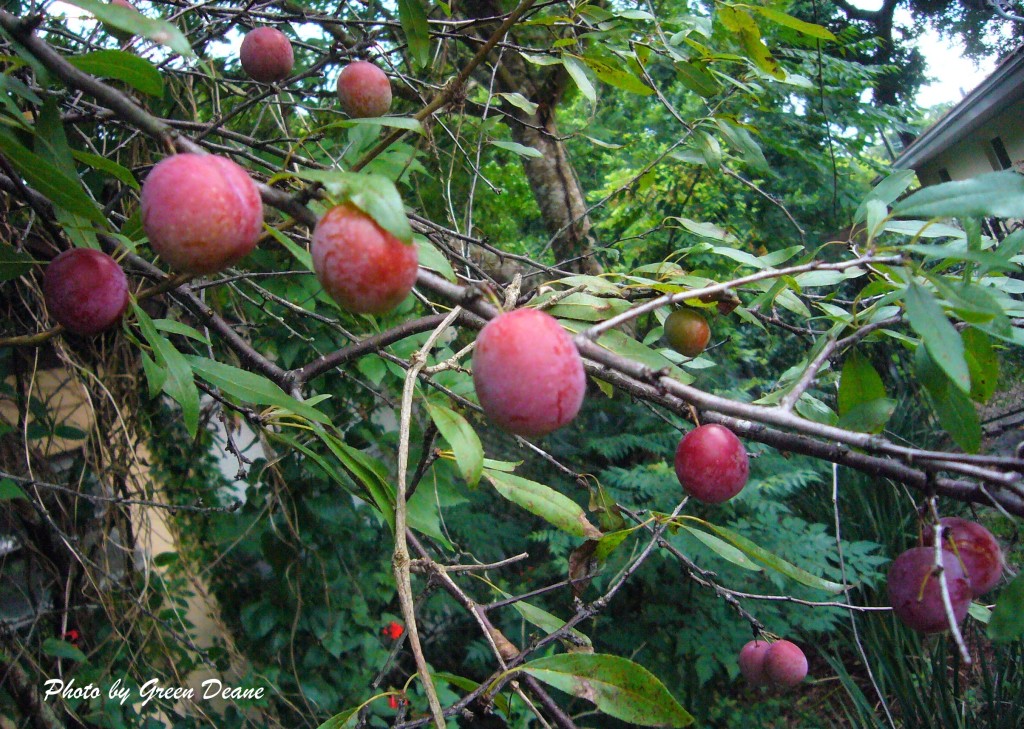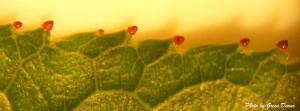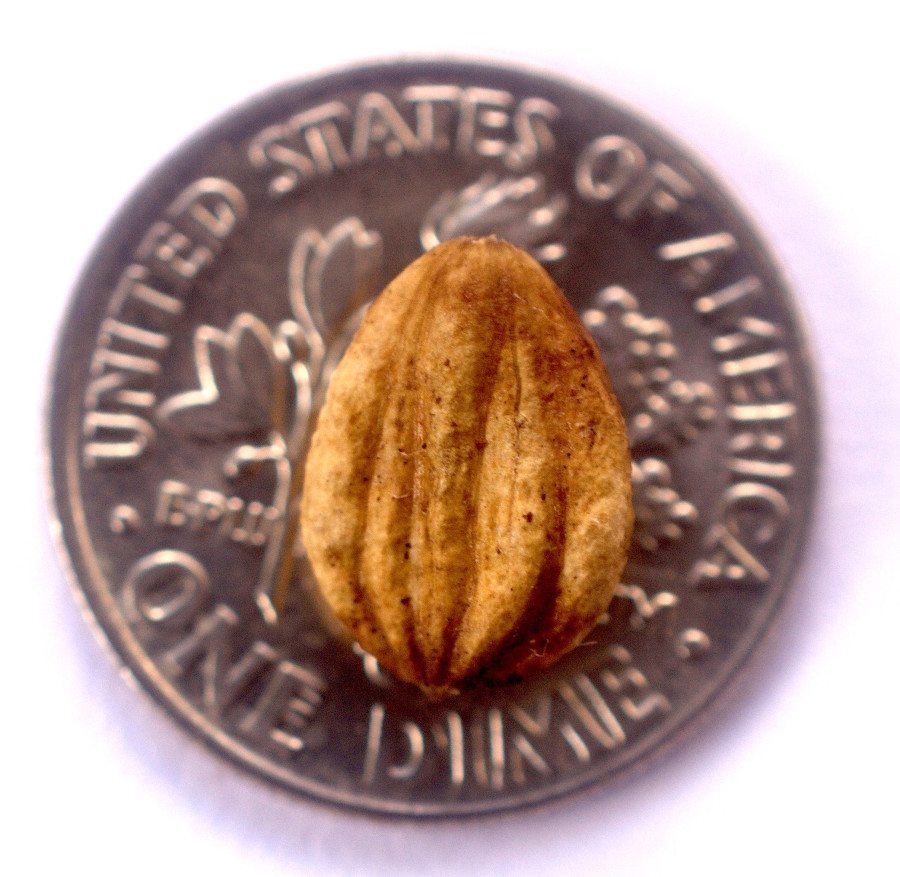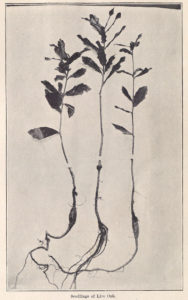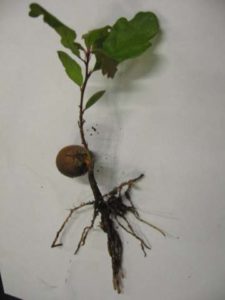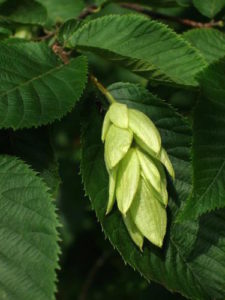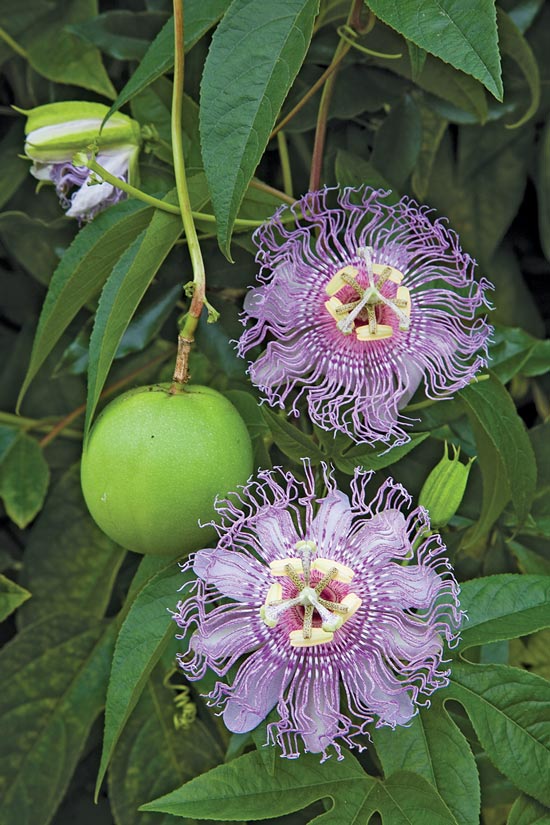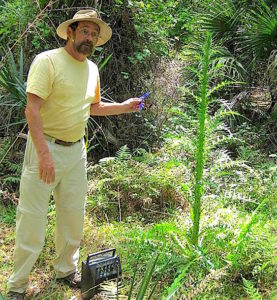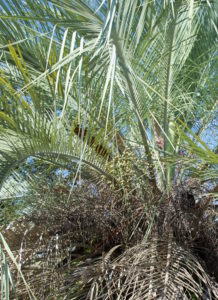This newsletter will be going out on a limb and visiting a few trees. Trees are not the first wild edible most people study. They usually start with weeds, of which there are a lot. They might add pines or oaks along the way, maybe birches if you live where they are common. But at some point, usually before moving on to grasses, foragers add trees to their wild repertoire. Grasses usually come next and then mushrooms. In some ways grasses are more difficult than mushroom but those two group usually follow weeds and trees.
During our foraging class last week in Gainesville the plums were happy. We saw two species fruiting, one approaching ripe. They were the Chickasaw Plum and the Flatwood Plum. The leaves — see photo left — can help you sort them out as well as when the fruit ripens. The Flatwood plums won’t ripen for several weeks or longer. The fruit can persist and is bitter and sour. I have found Flatwood plums in September that were still not palatable. The Chickasaw Plum, however, is a tasty tree fruit. The ones we found were on the small side with a slight pucker, perhaps a result of low rainfall. Native to Texas and Oklahoma they have been naturalized in the South Atlantic and Gulf States. You can read about the plums here.
One cannot mention bitter and sour tree fruit without mentioning the Black Gum. There are several “gum” trees including the Sweet Gum which most folks know because of its painful foot-puncturing fruit. It’s called “Sweet Gum” because it is the least offensive off all the gums. The Black Gum a fairly easy tree to identify, grows tall, sometimes to 100 feet, and is found from southern Maine to southeastern Wisconsin, south to Florida and Texas. Most of its branches, oddly, are at 90 degree angles from the trunk. And if you scrape the skin and pulp off the fruit the seed has longitudinal striations. One book I reference often is Cornucopia II. But I seriously doubt the author ever tried the Black Gum fruit for he wrote: “The bluish fruit have a thin, sharply acid pulp that is pleasant to roll in the mouth as a masticatory.” Every fruit I have ever tried has been extremely bitter and very sour. In my foraging classes they are the least liked fruit we try. You can read about the Gums trees here.
A century ago a pamphlet was published by a W.C. Coker on “The Seedlings Of The Live Oak and White Oak.” Coker referenced an article called “The Acorns And Their Germinations” by a Dr. Engelmann in Vol IV, 1880, of the Academy of Science of St. Louis. He in turn was referencing three fellows in South Carolina one of whom, William St. John Mazyck, made the original observation. Englemann wrote: “The structure of the acorns and the germination of the oaks seem to be so well-known, that I did not pay much further attention to it until my interest was excited by the information that the germination Live Oak developed little tubers, well-known to … children and greedily eaten by them….”
Essentially they write that after the acorn sprouts and sends up a young shoot the root develops a small elongated swelling that is edible. They agreed the swelling contains starch. The question they were discussing was when does the “tuber” form and how long does it last? They suspected it formed before the young shoot developed many true leaves. The swelling persists but grows woody in a few years. The “plate” in the pamphlet (above left) showed older oaks shoots but was used to show the swelling location when younger. One question was why would some species do this and the possible answer was hard times, or if you’re an oak, bad weather. The starchy swelling would help feed the seedling.
I happened upon this 140-year old information last week but did not find any follow-up correspondence. And I have not had the opportunity to scrounge around to see if I can find said swellings to learn if indeed they are edible. But I thought it interesting enough to share. If true oak swellings might be a nice addition to the wild menu. This would be particularly good if they were edible as is and didn’t need any processing. That also raises the idea of sprouting acorns as a crop.
As one might expect sometimes plant identification doesn’t go as one planned. During the Gainesville trip I harvested some plants before the class that did not grow in the area we were studying. In the early-morning light I thought was Barnyard Grass, a totally misnamed plant that likes to grow in very damp places or actually in water. But when it came to show the plant to the class it was missing one key identifier. It was growing in a wet spot, it was hairy and purple at the base but it was where the blade met the stem that the identification changed. Barnyard Grass is unique in that it has no growth where the blade meets the stem. This grass had a hairy growth there. Plan B. Later I wasn’t paying enough attention (we’re back to trees now) in an area where there are Florida Elms. I noticed the correct type of leaf but just didn’t think about the papery seeds. The tree was actually a Hophornbeam, Ostrya virginiana. It is, as one might think, closely related to the Hornbeam. The latter has edible seeds. I think the Hophornbeam’s seeds are too small to be bothered with. Both trees are strong wood and used for tool handles and the like. While very closely related they rarely grow near each other, one liking hills and the other low land.
Maypops are not called Maypop because you can stomp on them in May and they “pop.” Or said another way you can stomp on them in September and they’re not called “Septemberpops.” Their name “Maypop” is an English “cognate” of the Native American name, Maracock. That they are big enough now for schoolboys to step on and make a noice is just one of those natural coincidences. This weekend there were dozens of unripe fruit to taste but no sweet and sour ripe ones. The green fruit can be sliced and cooked (and even nibbled on raw) but it’s the inside of the ripe fruit that is the most tasty. One interesting aspect of the Maypop is that it’s a major natural source of GABA, gamma aminobutyric acid, which calms people. You can read about the Maypop here.
FORAGING CLASSES: Heading west this weekend for a foraging class in John Chestnut Park in Palm Harbor. It’s a nice location on the shore of Lake Tarpon. There also a resident deer herd we might get a glimpse of. Note two classes in June are on Saturdays, Colby-Alderman Park in Cassadaga — a nice location — and Florida State College in Jacksonville, always an interesting area.
Sunday, June 4th, John Chestnut County Park: 2200 East Lake Road, Palm Harbor, FL 9 a.m. 34685.
Saturday, June 10th, Colby-Alderman Park: 1099 Massachusetts Street, Cassadaga. Fla. 32706. 9 a.m.
Sunday, June 11th, Bayshore Live Oak Park, Bayshore Drive. Port Charlotte. 9 a.m. Meet at the parking lot at the intersection of Bayshore Road and Ganyard Street.
Saturday, June 17th, Florida State College, south campus, 11901 Beach Blvd., Jacksonville, 32246. 9 a.m.
Sunday, June 18th, Blanchard Park, 10501 Jay Blanchard Trail, Orlando, FL 32817. 9 a.m. Meet east side of the tennis courts near the YMCA building.
To read more about the foraging classes go here.
Want to identify a plant? Looking for a foraging reference? Do you have a UFO, an Unidentified Flowering Object you want identified? On the Green Deane Forum we chat about foraging all year. And it’s not just about warm-weather plants or just North American flora. Many nations around the world share common weeds so there’s a lot to talk about. There’s also more than weeds. The reference section has information for foraging around the world. There are also articles on food preservation, and forgotten skills from making bows to fermenting food. One special section is “From the Frightening Mail Bag” where we learn from people’s mistakes. You can join the forum by clicking on the button on the upper right hand side of this page.
All of Green Deane’s videos available for free on You Tube. They do have ads on them so every time you watch a Green Deane video I get a quarter of one cent. Four views, one cent. Not exactly a large money-maker but it helps pays for this newsletter. If you want to see the videos without ads and some in slightly better quality you can order the DVD set. It is nine DVDs with 15 videos on each. Many people want their own copy of the videos or they have a slow service and its easier to order then to watch them on-line. They make a good gift for that forager you know. Individual DVDs can also be ordered. You can order them by clicking on the button on the top right of this page or you can go here.
This is issue 259
If you would like to donate to Eat The Weeds please click here.

